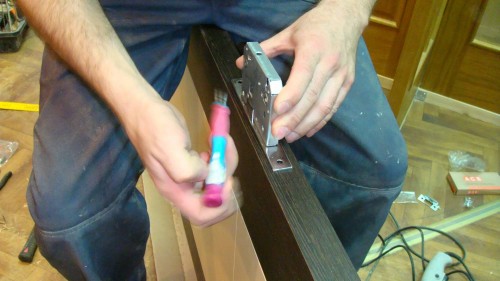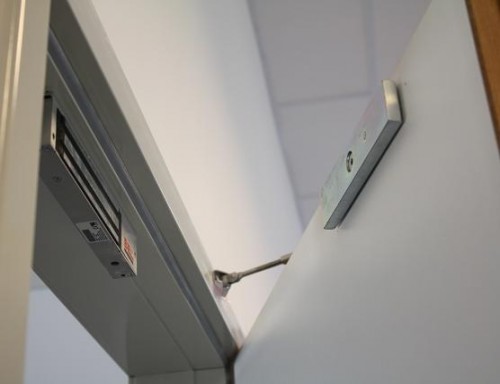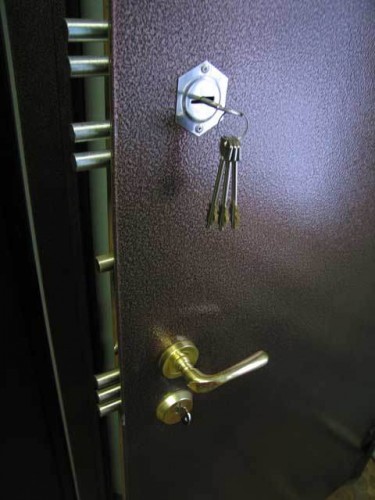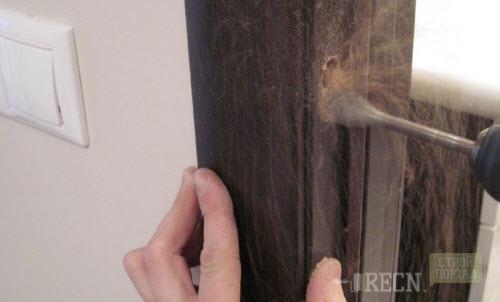
Installation instructions lock on the door Doors,Plumbing

Installation of the lock on the door is not a challenge, the execution of which can be trusted only by professionals. It is not worth spending money to pay for the wage of hired workers if you have the necessary tools at your disposal. It does not matter, metal is a door or wooden, input or interroom: the principles of work are the same. But some nuances, nevertheless, exist, and they should be considered.
Content
General recommendations
If the lock in the interior door performs, most often, decorative function, then for the input door it serves as a safety agent. The choice and installation of the lock on the front door installed on the dwelling boundary requires a serious relationship.
Do not trust one castle: you need to install, at least two. The distance between them should be no less than 300 mm. This will seriously complicate the task of the "Dushnik".
Self installation of locks - the best guarantee that the attacker will not be able to make copies of keys. About how to install locks of various types, tell me in this article.
Tool required for work
You must have everything you need to install the lock at hand. Tools and consumables will be needed:
- Wood milling (for sampling of wood under the castle body);
- screwdriver for screwing the screws and screws or a set of manual screwdrivers;
- Electrode with a set of drills - to prepare mounting holes;
- hammer;
- well sharpened chisels width 20 and 40 mm;
- Finger drills for the preparation of large diameter holes;
- line, roulette, pencil, square and millimeter paper;
- Self-tapping screws, screws, painting tape.
How to install an overhead lock
Overhead locks are installed at the inlet doors, wooden and metal. The sequence of work is as follows.
1. Instructions for installing the lock on the door should be carefully studied, the specification attached to the acquired product is drilled with the package.
2. We put the lock on the blank sheet of paper (it is preferable to use a millimeter), result in a pencil along the contour of the case.
3. On the lock template, mark the location of the key well and mounting holes.
4. Over the position of the position of the keyhole, we apply the guide for the key and correct the sizes of the hole.
5. I fastened the resulting stencil on the door at the location of the castle and transfer the locking well to it and all the locking points of the lock. In the event that the door is made of metal, the fastening pins should be welded at the lock points of the lock.
6. Combining the grooves for the key, secure the guide for the key to the lock case and fix it to it to the door with the help of self-tapping screws (for a wooden door) or on fastening pins (for metallic).
7. On the outside of the door, we screw the decorative pad on the keyhole.
8. Turning the key in the well twice (so that the rigels come out), we install and screw the shut-off strip.
9. To accurately install a retaliatory bar on the box, the end side of the riglels must be lubricating the paint or outline by the coal. Tightly sticking the door, we turn the key several times so that marks appear on the door frame. They will be on the site of holes for the entrance of the riglels.
10. Clearly note the centers of the holes and drill them to the desired depth. We apply the response bar during operation to control the location of the centers of the holes.
11. Krepim's response and check the functioning of the lock. If the riglels are free - the task can be considered solved. When the details are detected, it is necessary to perform "fitting": shift the retaliatory bar or cutting the edges of the holes with a round file.
12. In the event that, instead of the response, a special box is used, it is determined by its location by putting kicking the lock completely. Along them, we celebrate the place of attachment, after which we screw the box with self-draws.
Installing the castle in the interroom door
The door separating residential premises is made of wood or other materials with similar density characteristics (DVP, chipboard). Installation of locks in a wooden door is performed in accordance with the following rules.
1. The door canvas must be reliably installed on the end in a vertical position: for this it is necessary to use stapels, but in the absence of furniture items.
2. We note the place for the lock tongue: usually, a distance of 1000 mm from the floor is postponed.

3. From the marked point, we carry out the markup with the help of the coated and the pencil, and then we apply the lock to this line so that the center of the opening coincides with the linte.
4. On the canvase, we mark the lower and upper boundaries of the lock and the position of its housing. With the help of the carbon mark, we carry on the door end and glue the painting tape to limit the zone of the mill.
5. We select the mill in accordance with the thickness of the lock of the lock and, focusing on the marked painting ribbon, choose wood in the center of the end.

6. For the castle, we prepare the landing "nest": in the middle of the deepening made by the mill, the longitudinal line. With the help of an electric drill with a featuring a suitable diameter, the holes are drilled as close to each other.
Important! The diameter and the length of the drill must be selected so that the hole obtained with it does not exceed the size of the lock case. You can limit the length with a marker: the mark must be made on the drill, postponing the desired distance from its top.
7. Remove excess wood with the help of the chisels and hammer: first we use large, then smaller size.
8. Applying the lock case to the canvas, focusing on the previously applied markup, mark future holes to install the handle and for the key well.
Drive a hole for the handle is necessary on both sides. When drilling on the one hand, wood can be broken.
9. In the prepared "nest" insert the castle and fix it with self-draws. After installing decorative linings, secure the handle.
10. The response of the lock is arranged in the same way as described in paragraph 9 - 11 instructions for installing the padlock.
Installation of locks in a metal door
The procedure for installing the lock to the inlet door from the metal is the same as in the case of a wooden door. But there are differences. Installing the lock in the rail door requires the use of other tools. Need to have:
- Electric drill with a set of metal drills;
- Bulgarian;
- Filter, feet;
- metal screws;
- roulette, screwdriver.
To install the lock, select the location on the side of diagonally and perpendicular to the rigid ribs. Next - the following procedure (for mortise lock).
1. Delay in the door of the door of the lock case (the end plate remains outside).
2. With the help of the grinder, drink a longitudinal hole where you insert the lock. According to the centers of the holes in the end bar, we make marks for which the holes drill to screw the screws for metal.
3. We plan holes for the handle and drill them on both sides with the help of electric drills.
4. Apply the lock to the door canvas. In those places where the keyhole should be, we make a mark and then drill a longitudinal hole. Insert temporarily lock and check the accuracy of the performed holes. Burzes are removed with the help of the leg and install the castle, fixing the brass plate with self-draws.
5. After you figure out the holes for entering the riggers in the doorway, welded from metal corners, drill them or cut out with a grinder, we draw the edges with a file.
A hole for riggers should be 2-3 mm crushed below the level of entry of the riglels. It is necessary to prevent the door jam in its shrinkage on the hinges.
6. After installing the lock, it is checked for its operation: in case of friction detection, the corresponding places are processed with a file.
Installing magnetic locks on the door
At the entrance to the entrance of apartment buildings set the locks of a special design. They are also used for warehouse, economic and industrial premises. Installing an electromagnetic lock on the door is performed in the same way as described above, but it is necessary to connect it to the electrical wiring to trigger the locking mechanism.

The wiring is performed by a flexible cable protected by a metal corrugated hose. Its lengths should be enough to fully open the door.




















